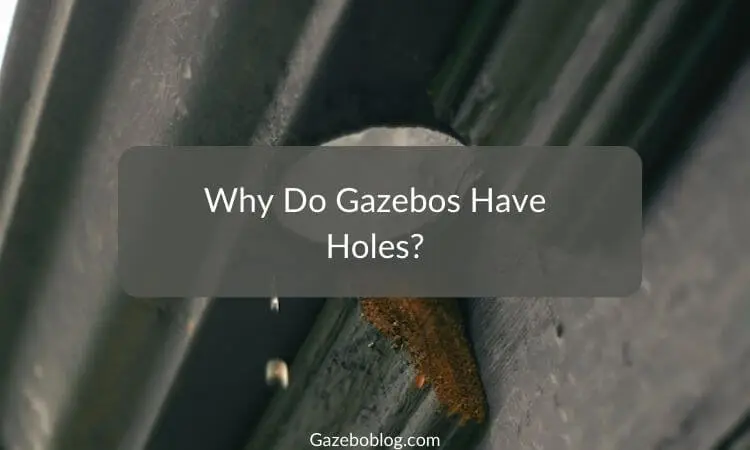Why Do Gazebos Have Holes? (Quick Guide)

Gazebos are outdoor structures that are popularly used for various purposes such as relaxing, entertaining guests, or even as an outdoor dining place. These structures are known for their unique design and are typically open on all sides providing a panoramic view of the surrounding area.
One feature that is commonly found in gazebos is the presence of holes in the structure and many people wonder why gazebos have holes. In this article, we will explore the different reasons behind this design feature.
Reasons Why Gazebos Have Holes:
Ventilation:
Perhaps the primary reason for gazebos having holes in their roofs is to provide ventilation. When the sun is shining, the temperature inside the gazebo can quickly rise, making it uncomfortable for people to sit inside. The holes in the roof allow hot air to escape, creating a cool and breezy atmosphere inside the gazebo, which is especially important during the summer months when the heat can be oppressive.
Light:
Another reason for having holes in the roofs of gazebos is to allow natural light to enter the space. While the roof provides shade and shelter from the sun, it can also make the gazebo feel dark and enclosed. The holes in the roof allow sunlight to filter through, brightening up the interior and creating a more inviting atmosphere. This is especially important if you plan to use the gazebo for reading, crafting, or other activities that require good lighting.
Structural Stability:
The holes in a gazebo's roof help improve its structural stability. When the wind blows, it can create an upward force that can lift the roof off the gazebo. However, the holes in the roof allow some of the wind to pass through, reducing the upward force and helping to keep the roof in place. This can be especially important in areas that are prone to strong winds or storms.
Rainwater Drainage:
In addition to their ventilation and structural benefits, the holes in gazebos can also serve as drainage points for rainwater. When it rains, water can collect on the roof and create a heavy load that can damage the structure. However, the holes in the roof allow the water to drain off, reducing the risk of damage and keeping the gazebo in good condition.
Mosquito Control:
Another benefit of the holes in an outdoor structure is that they can help keep mosquitoes and other insects out of the space. Some gazebos have mesh screens installed over the holes to prevent bugs from entering, and this can be especially important if you plan to use the gazebo during the summer months when mosquitoes are most active. The mesh screens allow air to flow through while keeping insects out, creating a comfortable and bug-free environment inside the gazebo.
Aesthetics:
In addition to their functional benefits, the holes in a gazebo can also enhance its aesthetic appeal. Depending on the design and placement of the holes, they can add visual interest to the structure and create a more elegant and sophisticated look. The holes can be circular, square, or even star-shaped, and they can be arranged in a variety of patterns to create a unique and eye-catching design.
Frequently Asked Questions (FAQ):
Why are there grommet holes in gazebos?
Grommet holes in gazebos are typically used to secure the canopy or curtains to the frame of the gazebo and may also be used to help in rainwater drainage. The size and placement of the grommet holes may vary depending on the design of the gazebo and the size of the canopy or curtains being used.
What is the purpose of ventilation holes in gazebos?
Ventilation holes allow air to circulate inside the gazebo, preventing it from becoming stuffy and humid. This is especially important if you plan to spend a lot of time inside the gazebo during hot summer days.
Are the holes in gazebos necessary for drainage?
Yes, the holes in gazebos are necessary for drainage as they allow water to escape from the roof and prevent it from pooling, which can cause damage to the structure over time.
How big are the holes in gazebos?
The size of the holes in gazebos can vary depending on the design and purpose of the gazebo.
Can the holes in gazebos be covered or closed?
The holes in gazebos should not be covered or closed as doing so may affect the gazebo's ability to drain water properly. If the holes are covered, water can accumulate on the roof and cause damage over time.
Do all types of gazebos have holes?
Not all gazebos have holes, but most modern models do. If you're purchasing a gazebo, check the product specifications to see if it has them or not.
Conclusion:
The holes in a gazebo's roof serve a variety of purposes including ventilation, aesthetics, structural stability, rainwater drainage, lighting, and mosquito control. These benefits make gazebos a popular choice for outdoor living spaces, providing shade, shelter, and a comfortable environment to relax and enjoy the outdoors.
Whether you are looking for a place to read, craft, or entertain guests, a gazebo with holes in its roof can provide the perfect setting for all your outdoor activities. If you found this article helpful, then share it with others and have a nice day.